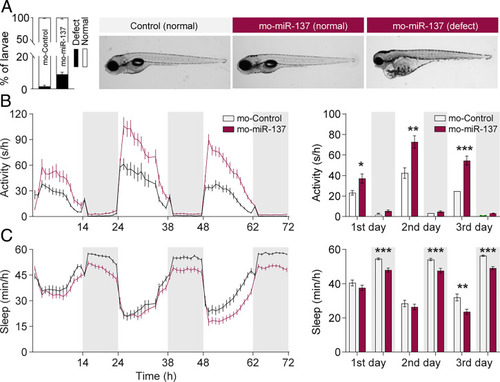Fig. 6
- ID
- ZDB-FIG-220725-60
- Publication
- Holm et al., 2022 - The evolutionarily conserved miRNA-137 targets the neuropeptide hypocretin/orexin and modulates the wake to sleep ratio
- Other Figures
- All Figure Page
- Back to All Figure Page
|
Knockdown of miR-137 increases locomotor activity and reduces sleep in zebrafish. (A) Morphological evaluation of zebrafish after knocking down miR-137. The developmental deficit rate in 5-dpf larvae is less than 10% (Left, combined dataset from four independent experiments, Mo-miR-137: n = 223, Mo-control; n = 207 fish). Right shows representative morphological images of normal and abnormal fish (Right). (B) Time course of the locomotion activity 5 to 7 dpf (Right), and the average activity per 14 h:10 h light:dark cycle (Left). Mo-miR-137 fish are significantly more active during the light phase than Mo-controls (Mo-miR-137 vs. Mo-control: P < 0.05 for light 5 dpf; P < 0.01 for light 6 dpf; P < 0.001 for light 7 dpf; F = 13.76; DF = 5; two-way ANOVA with Sidak post hoc test; *P < 0.05; **P < 0.01; ***P < 0.001; representative figure with Mo-miR-137: n = 48, Mo-control; n = 48 fish). (C) Time course of the amount of sleep 5 to 7 dpf (Right), and the average amount of sleep per light/dark cycle (Left). Mo-miR-137 fish sleep significantly less during dark periods than Mo-controls (Mo-miR-137 vs. Mo-control: P < 0.001 for dark 5 to 7 dpf; P < 0.01 for light 7 dpf; F = 2.79; DF = 5; two-way ANOVA with Sidak post hoc test; representative figure with Mo-miR-137: n = 48, Mo-control: n = 48 fish). |

